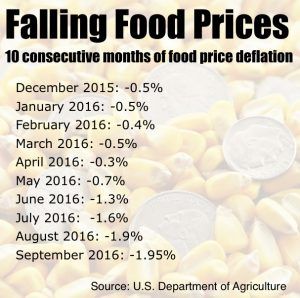The Supply Side: Grocery margins squeezed by deflationary prices may sting suppliers
by October 27, 2016 12:42 pm 227 views

Editor’s note: The Supply Side section of Talk Business & Politics focuses on the companies, organizations, issues and individuals engaged in providing products and services to retailers. The Supply Side is managed by Talk Business & Politics and sponsored by Propak Logistics.
–––––––––––––––––
Grocery is big business at Walmart U.S., but a 10-month run of deflationary prices combined with price rollbacks promised by the retail giant threaten supplier margins.
Margin pressures will be amplified as retailers like Dollar General, Kroger and Target follow the Walmart U.S. lead, according to UBS analyst Michael Lasser.
Lasser said in an investor note that Walmart’s aggressive price cuts could put $35 billion of business in jeopardy at Dollar General, Target and Family Dollar. He said Target is particularly vulnerable because 90% of its stores are within a 20-minute drive to a Walmart U.S. Supercenter. Lesser said the bulk of Walmart price cuts are in grocery, an area where Target is trying to gain share.
Lesser said there’s about $21 billion at risk at Target as a direct result of Walmart’s price cuts. He pegs the impact at Dollar General to be $9 billion, while Family Dollar’s risk about $4.5 billion. He said smaller players could be pushed out by the price cuts which would give Walmart U.S. more power with its suppliers.
‘UNPRECEDENTED’ DEFLATION
Grocery is 55% of Walmart’s sales and when deflationary food prices persist that’s a direct hit to the retailer’s top line revenue. Walmart has said revenue will grow 3% this year, but food prices in general have dropped almost 2% through the first nine months of 2016. Also, grocery spending likely fell for the third-straight quarter, said Zachary Fadem, an analyst at Wells Fargo Securities.

“The severity of what we’re seeing is completely unprecedented,” said Scott Mushkin, an analyst at Wolfe Research, who has studied grocery prices around the country for more than ten years. “We’ve never seen deflation this sharp.”
Mushkin said price competition and deflation are taking a toll on margins throughout the supply chain.
S&P Equity Analyst Joseph Agnese said meat, poultry, fish and dairy are responsible for about 52% of the more volatile perishable food category sales and about 30% of total grocery sales. These foods are seeing the biggest price declines.
Supplier consultants said Walmart already gets the rock bottom prices out of its suppliers but the suppliers often have better margins with other retailers. If everyone is cutting prices to remain competitive, supplier margins will be thinner at Target, Dollar chains and elsewhere.
PRODUCTIVITY LOOP
Wal-Mart Stores CEO Doug McMillon told suppliers at the Year Beginning meeting the retailer would be aggressive on absolute best pricing. Greg Foran, CEO of Walmart U.S., recently said price rollbacks do go lower margins, but lower prices often result in more units being sold which will eventually boost total revenue. That’s what Wal-Mart calls its “Productivity Loop.”

Small suppliers who already make pennies per unit sold and sell a lower volume than the major consumer packaged goods companies will struggle with the rollbacks and deflationary trends. It’s likely some smaller suppliers will be squeezed out if deflationary pricing pressures continue.
